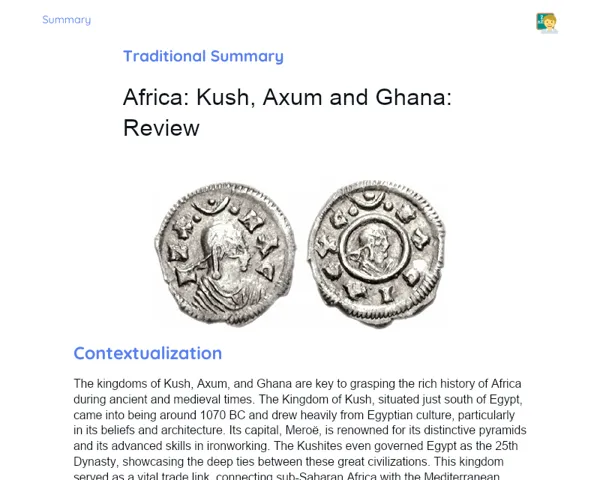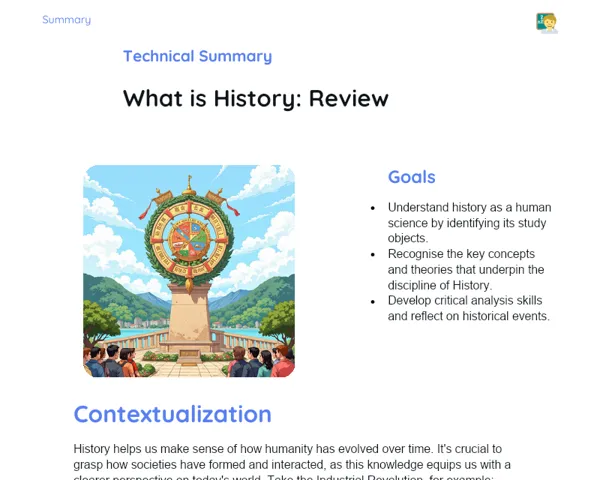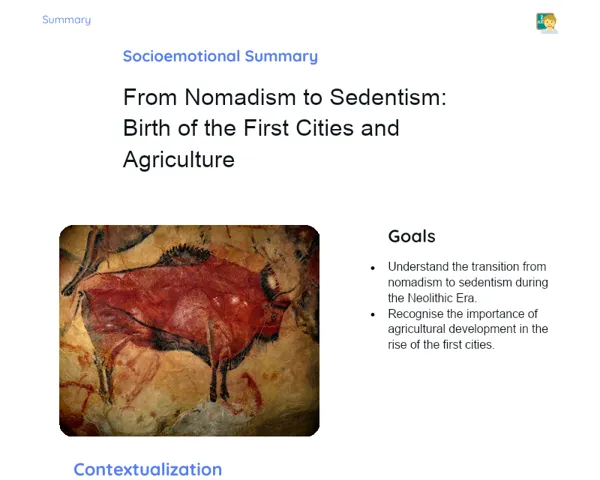Summary Tradisional | Spanish Colonization: Economy, Politics, Society, Colonial Pact, and Slavery
Contextualization
The Spanish colonization of the Americas, which kicked off in the late 1400s, stands as one of the most pivotal moments in world history. This process involved Spanish conquerors claiming vast territories, subjugating indigenous populations, introducing enslaved Africans, and rigorously exploiting natural resources in the New World. The colonial economy was defined by plantation agriculture, mining for precious metals, and the dominant influence of the Catholic Church, which helped reinforce colonial authority and spread Christianity among the native peoples.
Colonization not only transformed the political and economic landscape of the Americas but also had significant social and cultural ramifications. The imposition of an economy geared towards resource exploitation primarily benefited Spain, while stifling local development. Moreover, the interaction between Europeans, indigenous peoples, and Africans fostered a complicated web of power dynamics, resistance, and cultural blendings, the effects of which continue to shape contemporary Latin American societies.
To Remember!
The Conquest and Subjugation of Indigenous Peoples
The Spanish conquest of the Americas commenced with Christopher Columbus's landing in 1492 and expanded under conquerors like Hernán Cortés and Francisco Pizarro. Cortés famously toppled the Aztec Empire in Mexico through a clever mix of alliances, advanced weaponry, and psychological tactics. Pizarro used similar strategies to conquer the Inca Empire in Peru.
The conquest methods relied heavily on firearms, horses, and European armor, which were unknown to indigenous peoples and provided a crucial military advantage. Additionally, the Spanish took advantage of divisions within indigenous groups, forming alliances with rival tribes to overthrow large empires. They also spread tales that they were divine beings to instill fear and confusion among the indigenous people.
Equally important was the impact of European diseases like smallpox, which devastated indigenous populations. Lacking immunity, millions perished, making resistance to the conquerors even more difficult. This subjugation inflicted severe consequences on indigenous cultures, leading to death, enslavement, and loss of ancestral land.
-
Conquest driven by leaders like Hernán Cortés and Francisco Pizarro.
-
Utilisation of firearms, horses, and local alliances.
-
Destructive effect of European diseases on indigenous communities.
The Enslavement of Africans
The encomienda system was one of the earliest forms of forced labour implemented by the Spanish in the Americas, allowing settlers to demand tribute and labour from indigenous peoples in exchange for 'protection' and conversion to Christianity. However, as high mortality rates among the indigenous people due to this system became apparent, it gradually gave way to the direct enslavement of Africans.
From the 16th century onwards, the transatlantic slave trade began, forcibly bringing Africans to toil on plantations and in mines in Spanish territories. This trade resulted in the cruel deportation of millions who endured appalling working conditions. Plantations producing sugarcane, tobacco, and cocoa, alongside silver and gold mines, relied heavily on enslaved labour.
This shift from the encomienda system to direct slavery represented an escalation in brutality and dehumanization. Enslaved Africans not only endured exhausting work but also faced separation from their families and loss of cultural identities, laying the groundwork for overtly unequal and racially discriminatory societies in the Americas.
-
Transition from the encomienda system to direct enslavement.
-
The transatlantic slave trade’s impact on African populations.
-
Forced labour on plantations and in mines.
Colonial Economy
The Spanish colonial economy in the Americas was largely predicated on the exploitation of natural resources, particularly mining for precious metals. The city of Potosí, now in Bolivia, rose to prominence as one of the world’s leading silver mining centres, financing a considerable portion of the Spanish empire back in Europe.
Alongside mining, plantation agriculture was crucial. Vast lands cultivated crops like sugarcane, tobacco, and cocoa, primarily meant for exportation. These plantations relied on the forced labour of both indigenous peoples and enslaved Africans, who worked under brutal conditions to produce goods intended for European markets.
The colonial economy was also defined by trade routes and caravans that connected the colonies to Spain. This system was restricted by the Colonial Pact, which mandated that colonies trade exclusively with Spain, hindering their own economic growth and ensuring dependence on the metropolis.
-
Mining silver and gold as foundational economic activities.
-
Plantation agriculture focused on exports like sugarcane and tobacco.
-
Trade routes and the Colonial Pact limiting commerce.
The Role of the Catholic Church
The Catholic Church was instrumental in Spanish colonization, playing a dual role in though evangelising indigenous peoples and consolidating colonial rule. From the outset, Church officials accompanied conquerors, setting up missions throughout the New World to convert native peoples to Christianity.
The Jesuits were particularly active, establishing missions that functioned as education and conversion centres. Their influence was especially marked in Paraguay, where they created self-sufficient communities that protected indigenous peoples from the exploitative practices of Spanish settlers. However, the relationship between the Church and Spanish authority was not without its tensions, particularly over control of the missions.
Beyond evangelization, the Church also held substantial economic and political power, owning vast swathes of land and managing various revenue-generating activities from agriculture to mining. It acted as a mediator in disputes between settlers and colonial officials, having a direct impact on social and political dynamics in the colonies.
-
The Church's role in the evangelization of indigenous peoples.
-
Influence of Jesuits and tensions with colonial authority.
-
Widespread economic influence and political involvement of the Church.
Key Terms
-
Spanish Colonization
-
Colonial Economy
-
Colonial Politics
-
Colonial Society
-
Colonial Pact
-
Slavery
-
Indigenous Peoples
-
Mining
-
Plantation Agriculture
-
Catholic Church
-
Hernán Cortés
-
Francisco Pizarro
-
Encomienda
-
Evangelization
-
Slave Trade
Important Conclusions
The Spanish colonization of the Americas marked a historically significant chapter, characterised by the subjugation of indigenous peoples, the introduction of enslaved Africans, and the rigorous extraction of natural resources. The conquest led by figures like Hernán Cortés and Francisco Pizarro involved sophisticated military strategies as well as the devastation caused by foreign diseases. The resulting colonial economy, shaped by mining and plantation agriculture alongside the restrictive Colonial Pact, profoundly impacted the colonies’ social and economic fabrics.
The transition from the encomienda system to direct slavery underscored the extreme exploitation faced by Africans on plantations and in mines. The Catholic Church's role in both evangelising indigenous peoples and bolstering colonial power greatly influenced the political, economic, and social landscape of the colonies. These historical processes have left enduring marks on Latin American societies, contributing to the formation of deeply unequal and racially charged structures that can still be observed today.
Grasping the intricacies of Spanish colonization is essential for understanding the roots of social and economic disparities in present-day Latin America. The insights drawn from this period offer vital perspectives on current discussions surrounding cultural identity, human rights, and international relations. The historical richness of places like Potosí exemplifies the vast impacts of colonialism and underscores the importance of further investigation into these themes.
Study Tips
-
Review key events and historical figures of Spanish colonization, such as Hernán Cortés and Francisco Pizarro to understand conquest strategies.
-
Explore the encomienda system and its transition to direct slavery, focusing on the experiences of enslaved Africans in Spanish colonies.
-
Investigate the role of the Catholic Church in colonization, particularly Jesuit missions, and their effects on indigenous peoples.



